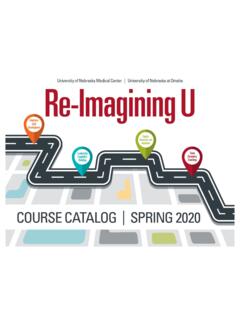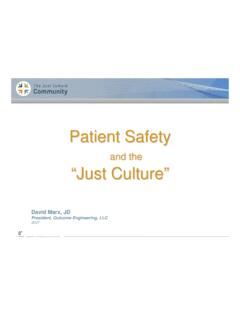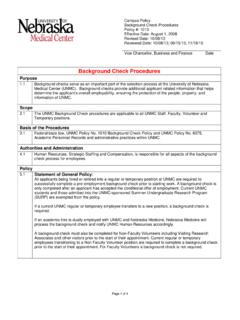Transcription of Fall Risk Assess Handout - University of Nebraska Medical ...
1 December 11, 2012 10:00 11:00 CST C A P T U R E Collaboration and Proactive Teamwork Used to Reduce Falls fall Risk Assessment: Best Practices for Nursing Staff in the Acute Care Setting Regina Nailon RN, PhD, Clinical Nurse Researcher The Nebraska Medical Center Deborah Conley, MSN, APRN-CNS, GCNS-BC, FNGNA Gerontological Clinical Nurse Specialist Nebraska Methodist Hospital This project is supported by grant number R18HS021429 from the Agency for Healthcare Research and Quality. The content is solely the responsibility of the authors and does not necessarily represent the official views of the Agency for Healthcare Research and Quality. 2 Acknowledgement Learning Objectives Review baseline data from 2011 hospital survey specific to fall risk assessment/communication.
2 Discuss published fall risk assessment tools. Conduct a fall risk assessment. Review main points and questions from attendees. 3 Introduction to Best Practices in fall Risk Assessment Part I: Introduction and Background 4 fall risk has been reduced in studies where interprofessional team members were actively engaged in fall risk reduction efforts. (Gowdy and Godfrey, 2003; Szumlas et al, 2004; von Renteln-Kruse and Krause, 2007) An interprofessional team (vs. nursing only strategy) and use of benchmarks are associated with sustained improvement (Sulla and McMyler, 2007; Krauss et al, 2008; Murphy et al, 2008) fall Reduction 5 The integration of best research evidence with clinical expertise and patient values -Sackett et al.
3 , 2000, Evidence Based is it? (Donabedian, 1980) Donabedian s Framework to Assess Quality Quality occurs within the context of patient care: Structure: infrastructure in place to support care provision (human resources, policy/procedures, equipment, environment) Process: actions taken to reduce fall risk (follow policy/procedures for fall risk reduction program, prevention interventions, staff/patient education) Outcome: fall rate/1000 patient days; injury fall rate/1000 patient days Structure Process Outcomes 2011 Falls Survey in NE Hospitals Examined structures-processes-outcomes related to fall risk reduction. 70 of 83 general community hospitals in NE responded (84%) 47 of 65 CAHs (72%) 13 of 18 non-CAHs (72%) 8 A fall is any unplanned descent to the floor with or without injury (NDNQI, 2012).
4 Injury levels can range from minor (bruising) to major (fracture, death). What is fall risk? Definition of fall / fall Risk 9 Hospitals with a fall risk reduction team had the lowest fall and injury fall rates compared to hospitals where one person or no one was accountable for implementing a fall risk reduction program. 39% (N=22) of critical access hospitals (CAHs) (<25 beds) that responded to the survey had either one individual or no one accountable for implementing a fall risk reduction program in their hospital. Baseline Survey Findings 2011 10 fall Risk Reduction Strategies: Structures Of 15 hospitals with no one accountable for fall Reduction, 33% (5) used a valid tool.
5 Of 16 hospitals with one individual accountable, 50% (8) used a valid tool. Of 39 hospitals with a team accountable, 56% (22) used a valid tool. 11 Do you use a validated, unmodified tool to Assess fall risk? fall Risk Reduction Strategies: Processes 013280102030405060708090100 Yes% of Hospitals by Team StructureNobody (n=15)Individual (n=16)Team (n=39) Of 15 hospitals with no one accountable for fall Reduction, 0% provided education. Of 16 hospitals with one individual accountable, 13% (2) provided education. Of 39 hospitals with a team accountable, 28% (11) provided education. 12 Does your team provide fall risk reduction education to staff via annual competency training and new employee education?
6 Discussing fall Risk in Daily Care 1425500102030405060708090100 Always/Frequently% of Hospitals by Team StructureNobody (n=15)Individual (n=16)Team (n=39) Of 15 hospitals with no one accountable for fall Reduction, 14% (2) discussed fall risk. Of 16 hospitals with one individual accountable, 25% (4) discussed fall risk. Of 39 hospitals with a team accountable, 50% (19) discussed fall risk. 13 Do patient care staff from multiple disciplines discuss patients fall risk in the context of daily care? Role of Communication 14 Do you communicate fall risk fall Risk Reduction Strategies: Processes Of the 15 hospitals with no one accountable, 0 performed risk assessments at these frequencies.
7 Of the 16 hospitals with one person accountable, 6% (1) performed risk assessments at these frequencies. Of the 39 hospitals with a team accountable, 23% (9) performed risk assessments at these frequencies. 15 Do nurses Assess a patient s fall risk at the following time points? 1)On admission 3) After a fall 2)Every shift 4) When status changes Best Practices for Assessing fall Risk in the Hospitalized Patient Part 2: Assessing fall Risk 16 fall risk assessment tools Published or home grown? Team approach to risk assessment Nursing-focused risk assessment tools PT-focused risk assessment tools Determining best tool for your hospital Sensitivity Specificity Frequency of assessing patient fall risk Documenting patient s fall risk status Assessing fall Risk 17 Evidence demonstrates patient variables that increase a patient s risk for falling.
8 Age (over age 65) Mentation Cognitive dysfunction, delirium, dementia Weak or Impaired mobility Assistance with toileting needs Medications Polypharmacy (4 or more drugs) Anticonvulsants, antipsychotics, benzodiazepines, antidepressants, Class IA antiarrythmics, opiates, sedatives, diuretics What to Assess for fall risk? 18 Evidence demonstrates environmental variables that increase a patient s risk for falling: Equipment IV pole Urinary catheter Physical hazards in room Poor lighting Lack of handrails in bathroom Poorly anchored rugs Clutter What to Assess for fall risk? 19 Injurious Falls In the next 15 seconds, an older adult will be treated in a hospital emergency department for injuries related to a fall .
9 In the next 29 minutes, an older adult will die from injuries sustained in a fall . Injurious falls are one of the most common adverse patient events in acute care. NCOA and CDC (2012) Targeting patients at Risk for Falls and Injury + Risk for fall -- No risk Injury + Risk for fall + Risk for injury -- No risk for fall -- No risk for injury -- No risk for fall + Risk for Injury fall Risk Matrix Risk for Injury-ABCs Does the patient meet any of the ABCs? Age 85+ Brittle bones (osteoporosis) Coagulation meds Surgical post-op Quigley, (2009) Which tool should we choose? How will I know it is the right tool for our hospital?
10 What fall risk factors is the tool assessing? Patient variables Environmental variables fall Risk Assessment Tool Selection 23 Nursing-based fall Risk Assessment Tool # Hospitals % Hospitals Morse fall Scale 29 Morse fall Scale Modified 8 Hendrich fall Risk Assessment 5 Hendrich fall Risk Assessment - Modified 2 Briggs fall Risk Assessment 2 Conley Scale 1 Schmid fall Risk Assessment 1 Schmid fall Risk Assessment - Modified 1 fall Risk Assessment Tools Used by Participating Hospitals Sensitivity is the ability of a fall risk assessment tool to correctly identify a fall risk patient Tells you how well the tool can correctly identify patients truly at risk










